Menu
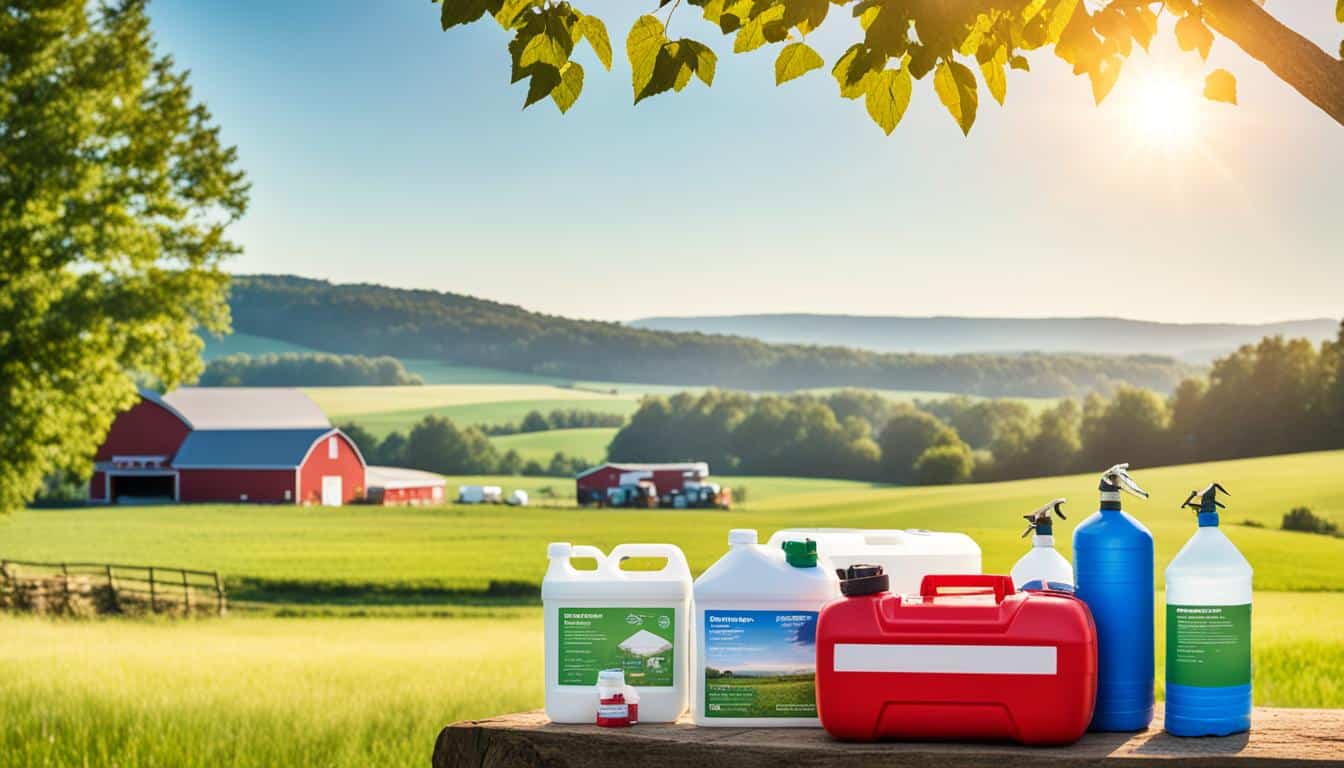
Did you know around 1,000 farm-related injuries need medical help each year in Iowa? This fact shows the big risks in farming. Farm emergency kits are very important. More than half of these injuries come from livestock, machinery, and from falling. So, it’s very crucial to be ready for emergencies on farms.
Farm injuries usually happen far from help, making it harder to get treatment quickly. This is why having the right emergency supplies for farmers is so important. These supplies should not just handle small injuries. They need to be ready for more serious accidents too. They must also have emergency contact numbers and clear directions to the farm.
It’s key to check emergency supplies every three months to make sure they are still good. Also, having first aid manuals and knowing first aid and CPR could save lives. Farmers often face big risks, with many needing hospital care for severe injuries. For example, 13 percent have fractures, and 4 percent need amputations.
It’s crucial for the farming sector to be ready for emergencies. This is to lessen disaster impacts and keep farm work going safely. Natural disasters like floods, hurricanes, and others hit rural areas hard, making farm disaster preparedness vital.
Putting together an emergency kit is key. Ready.gov advises having enough supplies for three days after a disaster. This includes water, food, medicines, and tools. Choosing crop protection supplies and livestock emergency supplies is crucial to protect both plants and animals well.
Farmers must plan ahead for emergencies, working with local emergency groups. These efforts save lives and protect animals and plants, cutting long-term economic losses. It’s also important to save nearby natural areas, helping lessen future disaster hits and build up resilience.
With the growing risks from climate change and bad weather, being ready for disasters is essential. Sharing emergency info, keeping track of farm items, and having important tools ready, like sandbags and fire extinguishers, lead to a strong emergency reaction. Working together with the community, cleaning up after disasters, supporting mental health, and managing trauma are crucial for full recovery.
Knowing warning signs and having emergency kits with crop protection supplies and livestock emergency supplies is vital. This readiness doesn’t just cut immediate dangers. It also makes the farming community stronger against future disasters.
Farmers deal with many dangers, which change based on the farm’s type and where it is. They often face risks from animals, machinery, and falls. These dangers, especially common in states like Iowa, can lead to big problems. If not dealt with quickly, small injuries can become serious. Farms are large areas, so help might take time to arrive, making each second count.
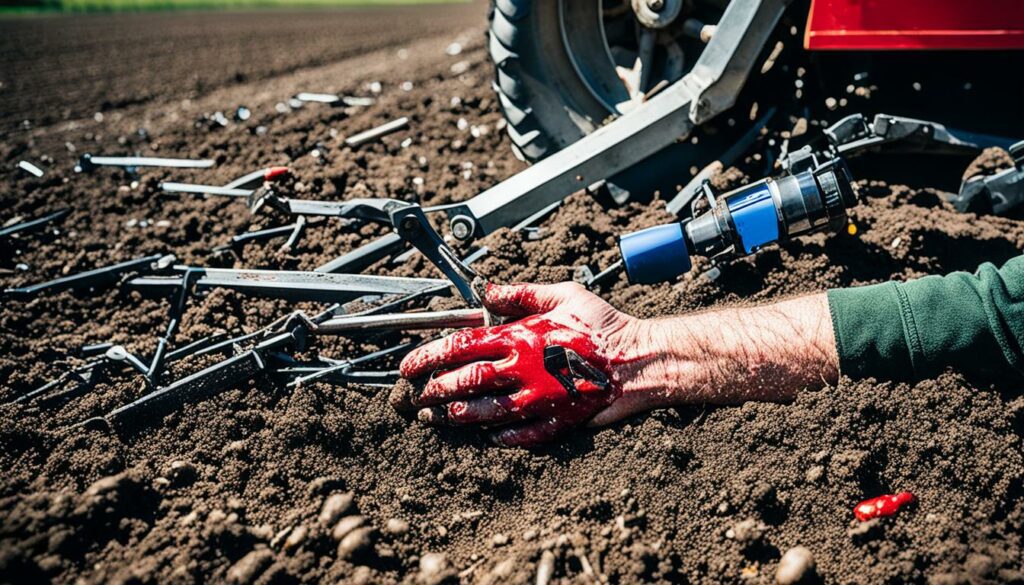
Surprisingly, only 20% of farmers have added safety features to their older tractors. Rollover accidents, one of the most deadly threats, can happen more to those without these protections. The high cost of safety retrofits, sometimes equalling the tractor’s price, holds many back. But this cost doesn’t match the injury and death toll from rollovers.
Additionally, severe weather farm supplies are critical, especially in areas with extreme weather. Farm supplies must be able to withstand strong weather to protect the workers and the farm itself. This means having sturdy shelters and tools for repairing any damage.
Knowing about how livestock act is key to avoiding accidents on the farm. Injuries from animals can be lessened by being gentle and using the right gear. Having a safety plan, such as knowing how to get away from dangerous animals, is crucial. And ensuring kids follow safety guidelines for vehicles can greatly reduce the risks.
Farm workers should have essential farm emergency supplies for the various dangers they face. These include hazardous chemicals and risky spaces that could lead to drowning or breathing in harmful gases. Regular safety training, like Health and Safety Awareness Days (SHADs), is important. They offer useful tips and hands-on practice to deal with these dangers.
| Common Farm Accidents | Percentage of Fatal Injuries |
|---|---|
| Vehicle and Machinery Accidents | 33% |
| Falls from Heights | 25% |
| Lifting and Handling | 20% |
| Hazardous Substances | 15% |
| Others | 7% |
Keeping essential farm emergency supplies ready and providing proper training is crucial. Fast, educated responses can stop small problems from becoming big ones. This protects the health and lives of those working hard in agriculture.
Creating a farm emergency kit is vital for farm safety. Every region faces its own set of disasters, such as tornadoes and floods. Your kit should have both basic and specific items for your farm.
Every farm should have some basic supplies for emergencies. These include:
Make sure to check and replace old items in your kit every three months.
Each farm’s emergency supplies should fit its unique needs. For farms with animals, consider adding:
It’s also key to keep a list of all things on the farm. This includes animals, crops, machinery, and any dangerous substances. This helps make sure everything important is covered during an emergency.
This method allows farmers to prepare for emergencies well. It keeps the farm running safely and gives peace of mind.
A well-stocked first aid kit is key for handling farm emergencies. It can turn a crisis into a manageable situation. Farmers face specific risks due to their work. This includes working with livestock and machinery, which often leads to injuries. Such incidents cause 1,000 farm-related injuries needing medical care each year in Iowa alone.
Fractures make up 13% of these injuries, and about 4% result in amputation. It’s clear that farm first aid kits should have compress bandages and other essentials. Water for cleaning wounds and staying hydrated is critical too. These kits should be regularly checked to keep them up-to-date.
But, these kits are mostly for severe injuries, not minor ones. Having personal medical details and special supplies is crucial. Don’t forget a card with key contact numbers and a guide on first aid. These will offer fast help when needed most.
Although 64% of farmers have got an emergency kit, many miss having key phone numbers handy. And 87% haven’t pinpointed higher areas for asset safety. This points to the importance of detailed emergency plans.
Such plans should consider everything from essential contacts to backup irrigation systems. They ensure farms can keep going even after a major setback.
First aid kits are crucial on farms because injuries happen often. About 1,000 injuries a year in Iowa alone need medical help. These injuries come from working with animals, using machinery, and slipping or falling. It shows the importance of being ready with the right tools.
A farm first aid kit should contain items that suit farm life. This includes large bandages, gauze, ice packs, and antiseptic sprays. Also, gloves and safety pins are needed. The kit needs to be ready for serious injuries like fractures or amputations.
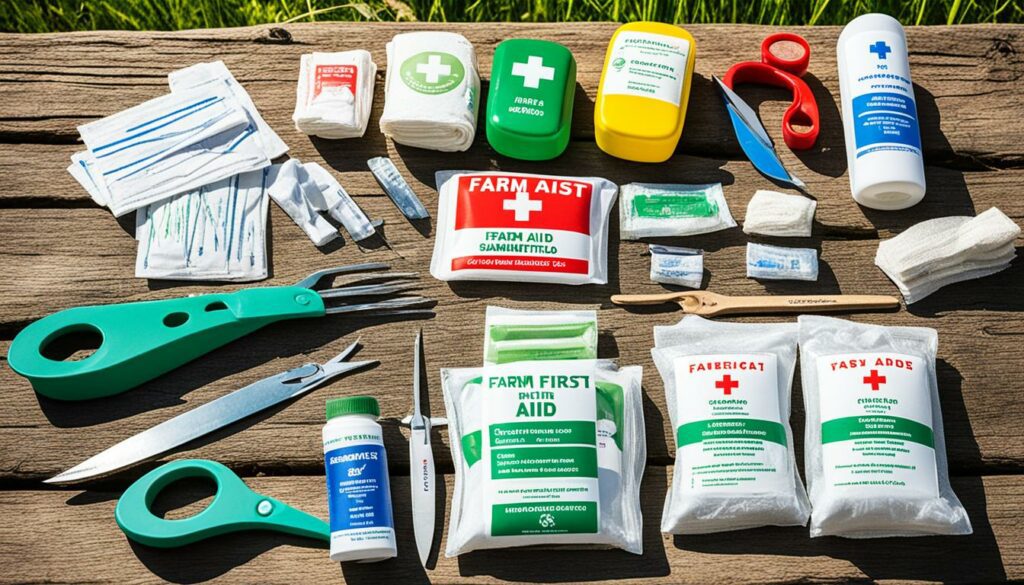
In a first aid kit with limited space, choosing items carefully is crucial. Include items like bandages, sterile gauze, and adhesive tapes. Also, add tools like triangular bandages and tongue depressors. Special kits for farm activities like tractor safety are also a good idea.
It’s important to keep first aid kits updated. They must be checked every three months. Make sure everything is within its use-by date and in good shape. Ice packs and batteries should be checked every year. Big kits are good for main buildings, while smaller ones suit vehicles. This approach means you’re always ready for an emergency.
It’s also smart to get CPR and first aid training. Having knowledge is just as important as having supplies. Create different first aid kits for every part of the farm. This makes sure you’re well-prepared for any danger.
Farmers need to be ready for possible *farm disasters*. They do this by using the right crop protection supplies. These supplies help reduce the harm from pests and bad weather like hail and frost.
Pest repellents and fungicides are key to keeping crops safe from diseases and bugs. Things like netting help stop insects and birds from damaging crops. It’s important for farmers to keep plenty of these supplies on hand.
Emergency tools are a must on any farm. For example, anti-hail nets can save crops from hailstones fast. Frost protection blankets are also important to keep plants safe from the cold. These tools show how being ready for disasters helps farmers act quickly and effectively.
Being prepared means having a plan. Farmers should plan how they’ll quickly protect their crops. A good plan helps make sure they use all available resources well to cut down on damage and loss.
Farmers face many dangers, making it vital to have the right livestock emergency supplies. A thousand farm injuries need medical help each year, often because of animals, machines, or slipping. It’s important to be ready. Thirteen percent of these injuries are fractures, with four percent leading to amputations.
Farmers must keep their animals safe with a well-stocked kit. This kit should have many items including:
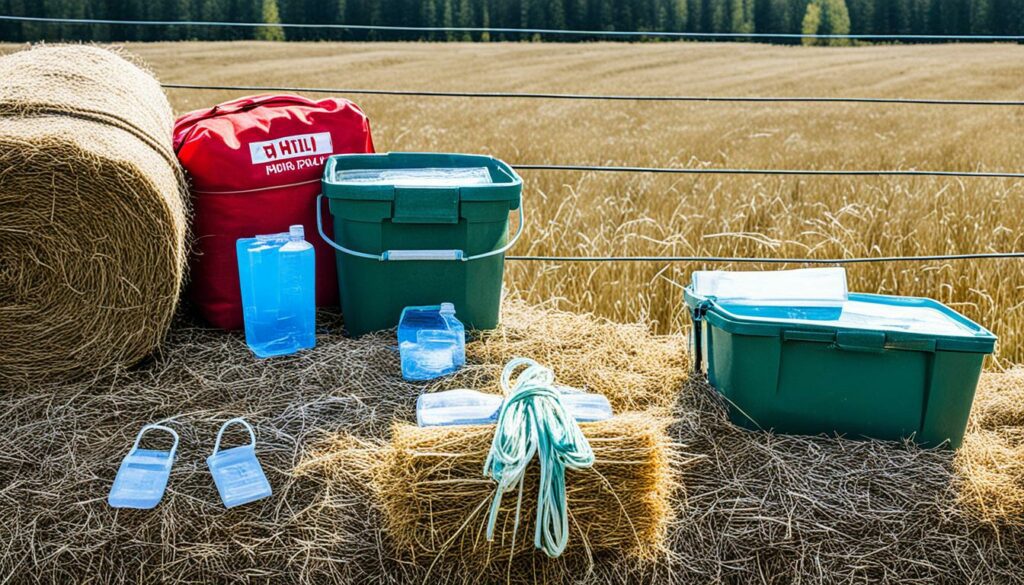
Tools like digital rectal thermometers and bandage scissors play a huge role in keeping animals healthy and safe. These kits mix natural and Western medicines. For example, goat milk is great for feeding various young animals, and prepared colostrum helps weak piglets and orphaned lambs.
Diapers can be used to protect livestock with wounds from blood. They show how important versatility is in these kits. Having a plan for fires is also crucial. It helps everyone know what to do fast if a fire breaks out.
| Item | Purpose | Key Use |
|---|---|---|
| Triple antibiotic ointment | Infection prevention | Apply to wounds |
| Goat milk | Nutritional support | Substitute for mother’s milk |
| Bandage scissors | Safe bandage removal | Minimise injury during removal |
| Digital rectal thermometer | Health monitoring | Measure animal temperature |
| Diapers for large animals | Wound management | Catch blood effectively |
Each farm is unique, so emergency supplies should fit its specific needs. Getting advice from a vet on what medical supplies to use is smart. This ensures the supplies are just right for keeping animals healthy and safe.
The role of backup power solutions in farming is critical. They’re necessary for activities like milk and egg production that depend on exact times. Without trustworthy power, a farm’s essential tasks would be at risk.
Big farms can lose a lot in just one hour without power. Think about the importance of water for crops, the need to keep food cold, and caring for animals. Generators for farms are key in keeping these operations going. Diesel generators are popular for their strong power and low upkeep. In places without easy access to power, like some farms are, natural gas ones are useful. They can also work with propane, making them even handier.
Global Power Supply is a top choice for backup power solutions in North America. They hold a wide variety of power equipment like generators, enclosures, and more. With their help, farming can run smoothly no matter what.
Battery-powered farm equipment adds an extra level of stability when power fails. This equipment is crucial for vital farm activities to carry on. It’s a big help, especially for farms moving to areas without regular power. There, these tools keep things going, just like generators do.
For the agricultural sector in the U.S., constant power is a must. It helps contribute over a trillion dollars to the economy. This power not only protects livestock but also boosts farm productivity.
To sum up, whether it’s through generators for farms or battery-powered farm equipment, reliable backup power is essential.
Irrigation systems keep crops healthy, but power outages can hurt them. It’s important to have irrigation backup systems in place. These keep the water flowing, even in emergencies.
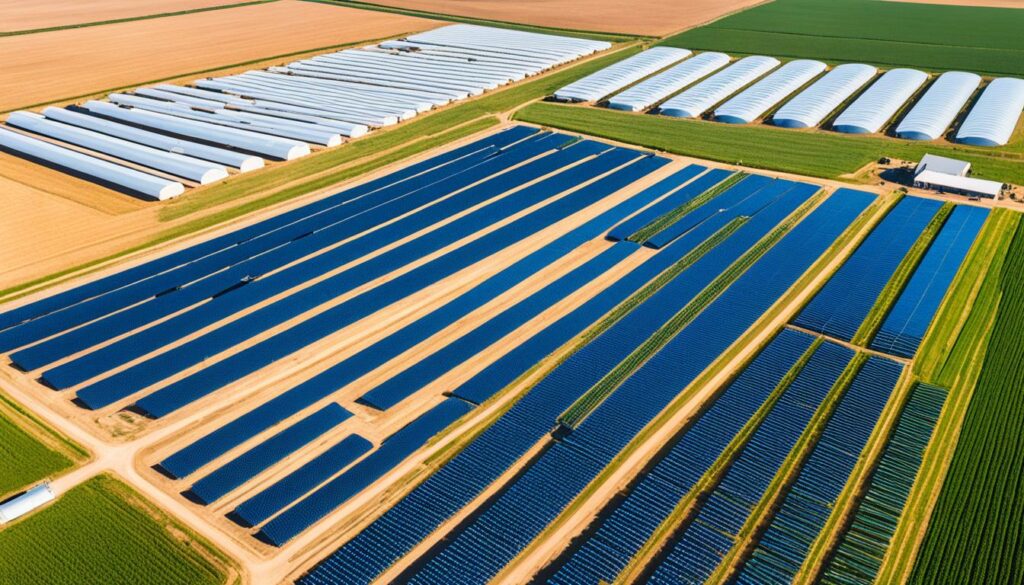
Diesel backup generators are common in farming, from poultry to greenhouses. They protect against the loss of power. For example, without power, farm-raised poultry and greenhouse plants suffer. So, having strong irrigation backup systems is vital.
American farming is big, adding over $1 trillion to the economy in 2019. It employs millions. To keep agriculture strong, reliable irrigation backup systems are a must.
Global Power Supply offers top-notch backup power systems for farms. Since 2004, they’ve provided everything from design to maintenance. This keeps farmers worry-free.
Farm and ranch owners face big risks from wildfires. Acting early can lower these risks, keeping people, animals, and crops safe. I will highlight key steps for farm wildfire protection, including preventions and what to do in an emergency.
Preventing wildfires is the first step to protect a farm. It’s essential to have a clear area around buildings. Keep a 5-foot area clean to stop flying embers from catching on fire.
Using Class A materials on roofs and metal joists cuts fire risk. It’s also important to cover vents with 1/8 inch metal screens. This blocks embers, helping to keep fires away from buildings.
Some plants can make fires worse. To lessen this danger, clear away plants and shrubs regularly. Plant trees and bushes that don’t burn easily and make fire breaks to slow or stop fires spreading.
After stopping a fire starting, having the right tools ready is key. Firefighters need powerful water pumps, fireproof blankets, and safe clothing. This gear helps them work in dangerous conditions.
Farmers must also prepare for bad weather that makes fire danger worse. They should have a plan to get people and animals to safety fast. Check routes and water sources regularly to make these plans work well.
Keeping good records of business info helps manage risks. A water source that fire trucks can easily access is also needed. Working closely with local fire services is key. They can provide support and advice to protect against fires.
Preparing for severe weather on farms is crucial. This is due to the many types of severe weather like hurricanes, tornadoes, and floods. These events can cause power failures and other problems. They especially underscore the need to have the right supplies ready for quick action.
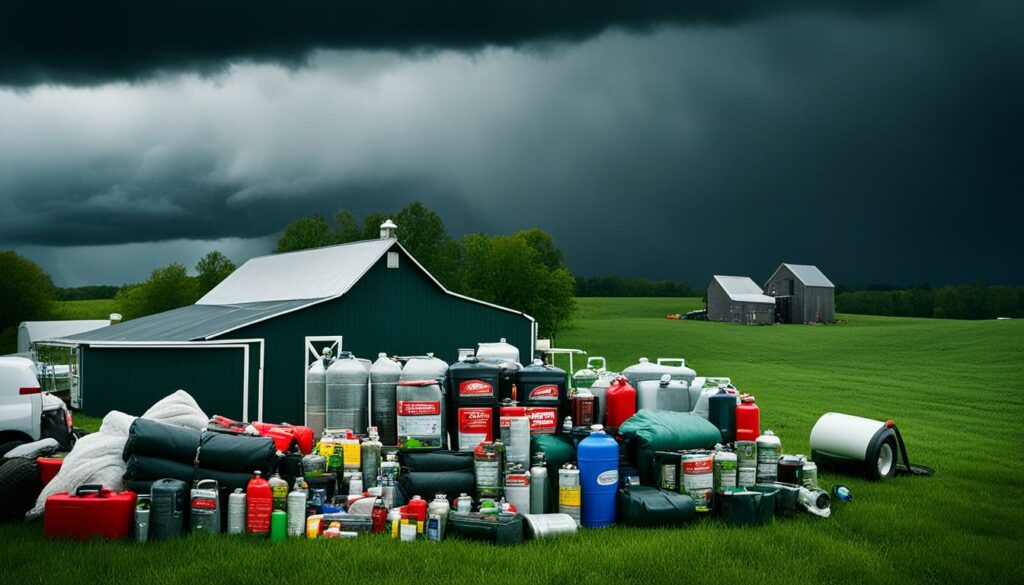
Livestock need special care during emergencies. Ensure you have what’s needed to take care of large animals, move them safely, and give them proper shelter. Have a disaster kit ready with food and water for both animals and people. A first aid kit for both animals and humans is a must for dealing with injuries during bad weather.
Transporting livestock safely requires the right gear like cages and trailers. Add tools such as shut-off wrenches and flashlights to your disaster kit. Don’t forget important documents and ID for the animals. Mark animals with All-Weather® Paintstik® markers to help organise emergency responses. This step can make a big difference in managing a crisis.
Review your emergency plan and supplies regularly. This helps your farm be ready for whatever the weather brings. By staying prepared, these supplies are key for farm safety and success.
In serious situations on farms, good communication can be life-saving. It’s crucial to have the right tools for various dangers like tornadoes, floods, and fires. These tools help farmers call for help and organise a response quickly and effectively.
Radios are a must for talking on the farm, especially when it’s big. They let workers coordinate fast and share updates from different spots. But, if the usual ways of talking stop working, like in bad weather or power cuts, satellite phones are a game-changer. They work on their own, outside of local networks. This means you can still reach emergency services or family not in the affected area.
When you need help, emergency signals like flares, whistles, and light sticks can save the day. They draw attention to your location, which is vital in far-off farm areas. A flare, for example, can be seen from really far, even when it’s hard to see. And a whistle stands out, cutting through other sounds. Keeping these emergency tools nearby and ready to use is wise for all farmers.
So, using a mix of tools like radios, satellite phones, and signals can help farmers deal with and respond to emergencies. This protects both people and their property.
Making sure farm workers stay safe in emergencies is vital for a safe and productive farm. It begins with thorough training and readiness. This not only keeps workers safe but also helps them know what to do in critical moments.
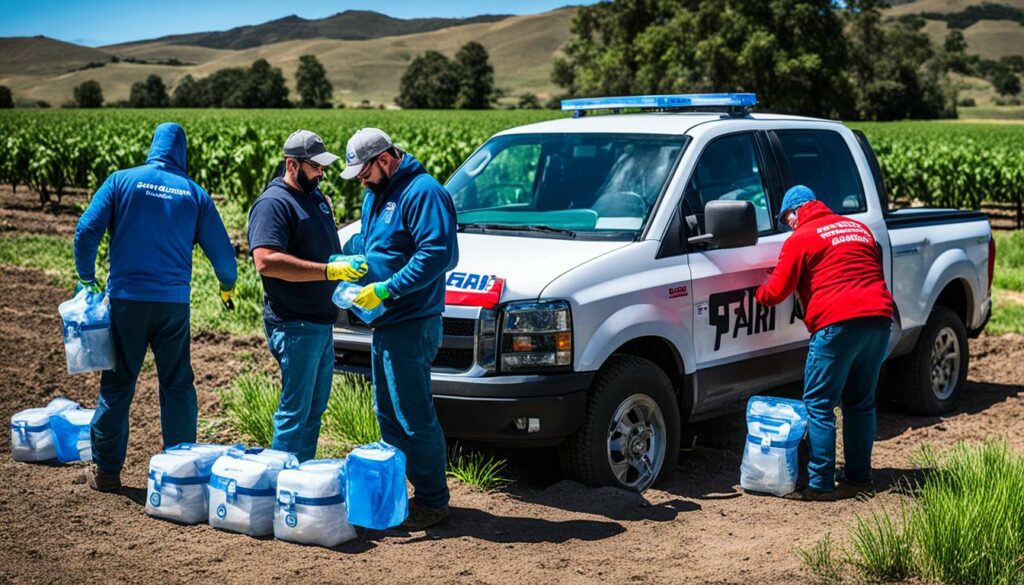
Having regular agricultural safety drills is key for getting the workforce ready for emergencies. Most farms, about 85%, have emergency plans ready. These plans make sure everyone knows where to go if they need to stay put or leave. Doing safety drills helps workers respond quickly and well in real emergencies.
These drills cover things like moving out of tight spaces and how to deal with machines breaking, and bad weather. Keeping these drills up to date with new info is crucial too.
The right PPE for farmers is very important for everyone’s safety on the farm. Good PPE includes things like gloves, goggles, strong shoes and clothes, which help reduce the dangers of chemicals, machines, and the weather. Women in farming might find it hard to get good PPE because it’s often not made with them in mind. Even with this issue, nearly 88% of farmers are careful about the PPE they have, showing how crucial it is. Making sure women have the PPE they need is part of keeping everyone safe.
Farming has many dangers, like chemicals and chainsaws that hurt about 36,000 people every year. To fight these risks, farms should have strong safety plans, offer regular training, and make sure everyone has PPE that fits well. Doing these things makes the farm a safer place for all.
It’s crucial for farmers to have key emergency supplies to face disasters and plan well. They should first focus on air, shelter, and water. The Rule of 3’s shows how important these essentials are.
It’s shocking to know over 50% of Americans are not ready for a $500 emergency. They often rely on credit cards. This fact tells us the importance of strong financial foundations, plus physical emergency items.
Many people prepare for emergencies, but they can make mistakes. For example, choosing luxury items over what’s really needed. Good training and planning are key for success in crisis response. Advice from credible sources like the United States Fire Administration and the Red Cross is vital.
To be well-prepared, farmers should have a three-day water supply. Those in areas prone to earthquakes should stockpile 14 days of water. Also, a quality first aid kit, such as the Adventure Medical Kits Sportsman 400, is essential.
In summary, a full approach including money planning, smart strategy, and regular supply checks is best for farmers. This sound investment both protects livelihoods and ensures farming goes on, even during hard times.
Key emergency supplies include a full first aid kit and backup power. Other essentials are systems for irrigation, items for protecting crops, and things for taking care of livestock in an emergency.
Being ready for disasters helps protect the farm and everyone on it. It makes sure the farm can keep going, even after a disaster. This can save lives and prevent huge losses.
Farmers often get hurt by animals, machinery, or falling. If a farm is far from help, injuries can be worse. So, having quick access to first aid is vital.
The best emergency kit should have basics like bandages and antiseptic. It needs special items too, like materials to make splints. The kit might also need unique things based on the farm’s needs.
It’s important to look over farm first aid kits every three months. This means checking for expired items and making sure the kit suits the season and the farm’s dangers.
In case of an emergency, farms need things like pest repellents and extra netting. Items to fight off frost or hail are also crucial. Quick access to these can lower the damage to crops.
Livestock kits must have first aid for animals, water, food, and needed tools. They should match what different animals need. This is key for treating injuries and lowering stress.
Backup power is vital to keep key farm machines working during blackouts. It ensures that milking and cooling systems don’t stop. This is critical for both safety and production.
For irrigation backups, you need alternative power, manual options, and ways to save water. These protect the crops by keeping them well-hydrated during crises.
Farms can guard against wildfires by making spaces that resist fire and planting the right plants. They need to keep emergency tools like water pumps and fire blankets on hand. Wearing the right gear is also crucial.
For rough weather, farms need strong shelters and ways to manage floods. Also important are items for controlling temperature and for moving debris or doing repairs. These tools aid in surviving and fixing the damage from bad weather.
Farmers should keep in hand radios and satellite phones in case normal phones don’t work. For drawing attention in danger, they need to have flares and similar signaling devices.
Keeping workers safe during crises means teaching them safety and giving them the right gear. This includes gloves, goggles, firm shoes, and special work clothes. Proper training and gear help cut down on accidents and make emergencies easier to manage.